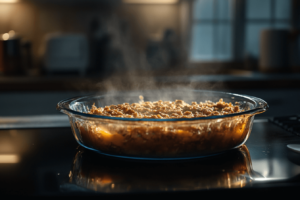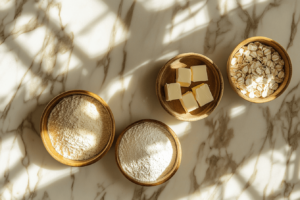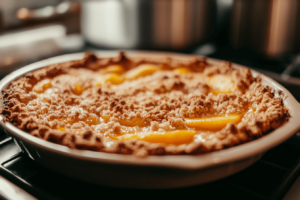Introduction
Peach crisp is a delightful dessert that brings sweet and tangy flavors together in one dish. Yet, it can sometimes turn out soggy or watery instead of crisp and golden. Many home cooks face this problem, and it is often frustrating. You might wonder why your peach crisp fails to deliver that perfect crunch. Fortunately, there are several easy fixes to avoid a soggy result.
In this article, we will look at common reasons that lead to a mushy peach crisp. We will also explore tips and tricks to help you get that firm topping you expect every single time. Moreover, we will discuss helpful baking steps and highlight small tweaks that can turn a soggy peach crisp into a lovely treat. By the end, you will feel prepared to tackle your next dessert with confidence.
As we move forward, keep in mind that understanding simple aspects of fruit dessert recipes is key. Peach crisp is not hard to make. Yet, it does need a bit of knowledge, practice, and care. If you have ever wondered, “Why is my peach crisp soggy?” or “Why is my peach crisp watery?” then this article will give you the answers. Let’s begin our journey toward mastering a crisp, crumbly, and mouthwatering peach crisp.
Why Is My Peach Crisp Soggy?
This question is common among fruit dessert lovers. In fact, “Why is my peach crisp soggy?” gets asked by both new bakers and seasoned cooks. A soggy peach crisp often results from extra moisture that the topping cannot handle. Also, not baking your dessert long enough or setting the temperature too low can lead to a watery or mushy texture.
Furthermore, the nature of peaches adds to the issue. Ripe peaches are juicy, which is wonderful for flavor. However, they release a lot of liquid as they bake. If the crisp topping, made of flour, sugar, butter, and other items, is too thin or not evenly placed, it will absorb these juices. Consequently, you end up with a wet or gummy layer on top.
Still, there is good news. With a few simple adjustments, you can avoid these pitfalls. Keep reading to uncover practical ways to prevent a soggy peach crisp. You will see that minor changes in ingredient choices and baking times make a big difference.
Understanding the Basics of Peach Crisp
Before diving deeper, it helps to know what makes a peach crisp stand out. A crisp typically includes fresh peaches, sugar (brown or white), and a touch of thickener such as cornstarch. The topping is what defines it: a crumbly mixture of flour, oats, butter, sugar, and perhaps cinnamon or other spices.
Yet, the topping and filling must work together. If the filling is too runny, the topping turns soggy. If the topping is not sturdy or does not form a protective layer, then the peaches’ natural juice will seep in. Although the flavor still remains, the texture suffers.
Therefore, the secret to a perfect peach crisp is balance. You want luscious and juicy fruit, but you also want a topping that contrasts with that softness. By maintaining the right ratio of fruit to topping and adjusting the baking process, you can create a dessert that is neither too dry nor too wet.
Common Reasons for a Soggy or Watery Peach Crisp
Learning about potential mistakes can help you avoid them. Below, we detail some of the main reasons behind a soggy or watery peach crisp.

Excess Moisture in the Fruit
Peaches contain a lot of water, especially when they are in season and fully ripe. As they bake, they release juice. This juice can mix with sugar or sweeteners in the filling. If there is too much sugar, it draws more water out of the peaches. Hence, the filling ends up liquid-heavy.
Additionally, frozen peaches can hold extra water from the freezing process. Thawing them poorly or using them straight from the freezer might amplify the water content. In either case, too much moisture is a leading cause of a soggy topping.
Not Enough Thickener
Cornstarch or flour acts as a thickening agent in many fruit crisps. If you do not add enough of these, the juices have nowhere to go. As a result, they flow into the topping. Meanwhile, too little thickener also prevents the filling from setting. This leads to a watery outcome, affecting both flavor and texture.
Improper Topping Distribution
When you scatter the topping unevenly, some areas of the crisp end up too thin. At the same time, thicker portions may cook more evenly, but the thin spots soak up fruit juices. Thus, your crisp might have inconsistent textures throughout. Even coverage allows the topping to brown nicely while shielding the peaches underneath.
Underbaking the Crisp
Baking at a low temperature or pulling the crisp out of the oven too early often results in a soft, soggy top. The topping must bake long enough to let the butter melt and the flour or oats toast. Also, the filling needs time to bubble and reduce in the oven. If you rush this step, extra moisture will remain, and your crisp will lack that golden, crunchy finish.
Using Cold or Hard Butter Incorrectly
Butter is a key ingredient in crisp toppings. If the butter is not mixed in properly, you might get dry patches or lumps that do not bake evenly. This can lead to parts of the topping soaking in fruit juices while other parts remain unfinished. When using cold butter, make sure to cut it into small pieces or grate it. Then, incorporate it quickly into the dry mixture.
Tips for Preventing a Soggy Peach Crisp
Now that we have identified the main culprits, let’s explore solutions. Preventing a soggy peach crisp is easier when you follow these tried-and-true tips.
Use Fresh, Firm Peaches
Choose peaches that are not overly ripe. Firmer peaches release less liquid. Moreover, they hold their shape better when exposed to heat. If you must use soft peaches, cut back on any added liquids and sweeteners. That way, your filling stands a better chance of thickening.
Increase or Adjust Your Thickener
A small tweak in the amount of cornstarch or flour can solve many problems. If your past peach crisps turned out too wet, try adding an extra tablespoon of cornstarch. Stir it well into your sliced peaches before adding sugar or other seasonings. Doing so helps ensure the juices will transform into a luscious syrup, not a watery mess.
Drain Excess Liquid
Sometimes, peaches or other fruits might be super juicy. In this case, sprinkle sugar on them in a bowl and let them sit for a few minutes. Then, drain any excess liquid that forms at the bottom. Next, add your thickener and proceed with the recipe. This method reduces the total amount of moisture going into the pan.
Properly Blend the Topping
Also, make sure your topping is well-combined before you place it on the peaches. You want a crumbly mix, yet each piece of butter should be coated in flour and oats. If you see dry flour at the bottom of your mixing bowl or large unblended lumps of butter, keep blending. A consistent topping forms a barrier against the fruit juices, which helps keep things crunchy.
Bake at the Right Temperature
A common mistake is baking at too low a temperature. Typically, a peach crisp should bake at around 350°F to 375°F. This allows enough heat to brown the topping while cooking the peaches all the way through. In addition, you should watch for visible signs. The fruit filling should bubble around the edges, and the topping should be golden brown. Do not be tempted to remove the pan early.
Let It Rest
After taking the crisp out of the oven, let it sit for at least 15 to 20 minutes. As it rests, the filling cools slightly. This pause allows the juices to thicken further. If you dive in too soon, it might look runny. With patience, you will find that the texture firms up, and the flavors meld more completely.
Choosing the Right Ingredients for a Perfect Peach Crisp
Picking the right ingredients sets the stage for success. Even though it may seem straightforward, each component in a peach crisp influences the final result.

Selecting Quality Peaches
Not all peaches are alike. In season, fresh peaches are usually bursting with flavor. Out of season, you might rely on frozen or canned peaches. When using frozen peaches, make sure to thaw them and pat them dry. This step reduces the liquid they bring to the recipe. If you opt for canned peaches, drain the syrup. Also, reduce added sugar because these peaches come pre-sweetened.
Best Flours and Oats
Many recipes call for all-purpose flour for the topping. This is a good choice, yet whole wheat flour can give a nuttier taste. If you prefer gluten-free options, you can try a blend of almond flour and gluten-free oat flour. For oats, old-fashioned rolled oats are ideal since they maintain more texture. Quick oats can work, but they might yield a softer topping.
The Right Butter or Fat
Butter is usually the best choice for flavor in a crisp topping. It browns well and creates a classic taste that pairs nicely with peaches. But you can replace some or all of the butter with coconut oil, especially if you want a dairy-free option. In any case, ensure you cut the fat into the dry ingredients until you get pea-sized clumps.
Balancing Sweetness
Peaches can be sweet on their own. Taste your fruit first. If they are very ripe, reduce the amount of sugar in the filling. Also, watch how much sugar goes into your topping. Brown sugar adds moisture, so if you find your crisp is often soggy, consider switching to white sugar or cutting back on brown sugar.
Steps to Achieve a Crisp Topping
While the filling is vital, the crisp topping is the star of the show. Follow these steps to get the best possible crunchy layer.
- Chill the Butter: Cold butter helps the topping stay crumbly. Keep your butter in the fridge until you are ready to use it.
- Mix Dry Ingredients First: Combine flour, oats, sugar, salt, and any spices in a bowl. This ensures that all flavors distribute evenly.
- Incorporate Butter Correctly: Cut the butter into small cubes. Then use a pastry blender, two forks, or your fingertips to rub the butter into the dry mixture. Stop when the mixture looks like coarse crumbs.
- Check Consistency: Squeeze a bit of the topping in your hand. It should stick together in small clumps, but it should not feel overly wet.
- Even Coverage: Spread the topping across the peaches, making sure no large gaps remain. Press gently to ensure contact, but do not pack it too firmly.
- Proper Baking: Bake in a preheated oven until the fruit bubbles and the topping is golden brown. This often takes around 30 to 40 minutes, though it can vary. Keep an eye on it in the last few minutes to prevent burning.
Common Baking Mistakes to Avoid
Understanding baking mistakes can keep you on the right track. Here are some pitfalls you should watch for:
- Too Much Liquid: Whether from the peaches themselves or added sweeteners, excess liquid leads to sogginess. Always measure your sugar and liquids carefully.
- Skipping the Thickener: Even if you do not like adding cornstarch or flour, it plays a big role in preventing a watery filling.
- Rushing the Bake: If you remove the crisp from the oven too soon, you end up with an undercooked, soggy top. Patience pays off.
- Using an Improper Dish: A shallow baking dish allows more surface area for the topping to brown evenly. A deeper dish can trap moisture, which increases the chance of sogginess.
- Ignoring Ingredient Temperature: Room temperature ingredients can blend differently than cold ones. Make sure you follow your recipe’s guidance for best results.
Alternate Methods and Variations
If you still find your peach crisp turning out soggy, try a few creative solutions. For instance, pre-cook your peaches on the stove with a small amount of sugar and cornstarch. Heat them until some of the water evaporates and the mixture thickens. Then, place them in a baking dish, top with the crumble, and bake. This approach reduces the chance of extra liquid pooling.
Moreover, you can experiment with different toppings. Some bakers mix chopped nuts like pecans or almonds into the crisp. Nuts add crunch and help reduce sogginess by absorbing some moisture. You can also try combining different fruits, such as peaches with blueberries or strawberries, for an extra layer of taste. However, always keep in mind that extra fruit might mean extra liquid. Adjust the thickener to avoid a watery outcome.
Finally, consider adjusting your oven’s temperature or using convection settings if available. Convection ovens circulate heat more evenly, which can help dry out the topping. Always follow safe baking practices, but do not be afraid to tweak your recipe to fit your oven’s unique quirks.
Frequently Asked Questions
How to keep fruit crisp from getting soggy?
Drain excess juice and use a proper thickener like cornstarch or flour. Also, ensure the topping is thick enough to block extra moisture. Bake until the fruit bubbles and the topping is golden.
How do you keep peach cobbler from getting soggy?
Use firmer peaches, add a little more thickener, and do not underbake. Let the cobbler sit after baking to allow the filling to set.
Why is my peach crisp watery?
Extra moisture from juicy peaches or insufficient thickener often causes a watery crisp. Too much sugar can also draw more liquid from the fruit.
Why is my crumble always soggy?
Uneven topping, incorrect baking temperature, and lack of thickener in the filling can lead to a soggy crumble. Also, avoid adding too much butter or sugar in the topping.

Conclusion
A soggy peach crisp can be disappointing, but it does not have to be the norm. By using firm peaches, controlling moisture, and baking at the right temperature, you can avoid the dreaded watery dessert. Furthermore, small tweaks like draining excess juice, adding an extra spoonful of thickener, or pre-cooking the fruit can make all the difference.
Remember that practice helps perfect your method. Each oven and set of ingredients can vary, so do not be discouraged if you need to experiment. Soon, you will delight in a crunchy, golden topping that contrasts beautifully with soft, juicy peaches beneath. Enjoy the process, and share your delicious, crisp creation with friends and family.

